 image located by Esteban Rivera,
22 April 2024
image located by Esteban Rivera,
22 April 2024
Last modified: 2025-01-04 by ian macdonald
Keywords: islam | shi'a | shi'ite | iran |
Links: FOTW homepage |
search |
disclaimer and copyright |
write us |
mirrors
 image located by Esteban Rivera,
22 April 2024
image located by Esteban Rivera,
22 April 2024
Abd al-Azim al-Hasan, commonly known as Shah Abdol-Azim and likewise Sayyid
al-Karim, is among those scholars who are from the progeny of the second Imam of
Shia Islam, Hasan ibn Ali. His complete name is Abu al-Qasim ‘Abd al-Azim bin
‘Abdillah bin ‘Ali bin al-Hasan bin Zayd (bin ‘Ali) bin al-Hasan bin ‘Ali bin
Abi Talib, transliterated simply as Abdolazim or even Abdulazim Hosni. Abd
al-Azim is also named Hazrat (transliterated Hadhrat) Abd al-Azim (al) Hasani
particularly in formal speaking/news.
Abd al-Azim, was among the
companions of the ninth and tenth Imams of Shia, namely Muhammad al-Jawad and
Ali al-Hadi. He died on November 2, 866, and is buried at the Shah Abdol-Azim
Shrine in Rey, Iran, with the first building of the mausoleum being erected ca.
III century BC.
Sources:
https://en.wikipedia.org/wiki/Abd_al-Azim_al-Hasani and
https://fa.wikipedia.org
The flag is a green horizontal background with the logo featuring three top
cupolas in different shades of green and above them a bigger cupola, surrounded
by a sunbeam.
For additional information go to Abdulazim (official website):
https://www.abdulazim.com/
Esteban Rivera,
22 April 2024
Logo
 image located by Esteban Rivera,
22 April 2024
image located by Esteban Rivera,
22 April 2024
Source:
https://en.abna24.com/news//changing-of-flag-ceremony-held-at-hazrat-masoumeh-holy-shrine-in-qom_957822.html
Caption: On the auspicious occasion of the birth anniversary of Hazrat
Fatemeh Masoumeh, [he daughter of Imam Musa Kazem and sister of Imam Reza], the
changing of the flag ceremony was carried out at her Holy Shrine in Qom, South
of Tehran, Iran; c. July 2019
William Garrison,
25 November 2019
 image located by William Garrison,
22 December 2019
image located by William Garrison,
22 December 2019
Source:
http://en.hawzahnews.com/news/353796/The-flag-of-holy-shrine-of-Fatemeh-Maasoume-a-s-to-be-gifted
Caption: The flag of the Shia Holy Shrine of Fatemeh Maasoume (or: Fatima Masumeh) in Qom, Iran [c. Dec. 22, 2019].
William Garrison,
22 December 2019
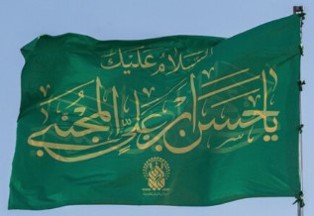 image located by William Garrison,
14 June 2024
image located by William Garrison,
14 June 2024
A flag that flies above the mausoleum/shrine of Lady "Fatimah bint Musa" or
"Fatima al-Ma'suma/Masumeh" (c. 790 AD - 816 AD), daughter of the seventh
"Twelver Shia Imam": Musa al-Kadhim/Kazim. During a family-visitation journey,
the young "Fatima" (literally meaning: "the immaculate") fell ill along the way
and died in Qom, Iran. She is revered for her piety in Twelver Shiism and her
Qom shrine is a major destination for pilgrimage. Shiite "Imams" are the
spiritual and political successors to the Islamic prophet Muhammad in the
"Twelver branch" of Shia Islam. Though Shi'i theology formally states that the
relatives of the Imams, or "Imamzadehs", hold a lower religious status than the
Imams, popular Shi'ism still strongly venerates the "imamzadehs" or "saints".
Her shrine's logo appears at the bottom of her flag. Reading the Arabic writing
from right-to-left, the thin top line reads: "Peace Be Upon You", and the larger
center slogan starts: "Ya/Oh, Fatimah...." Essentially this flag appeals for her
spiritual assistance to troubled Shia-Muslim devotees. [New flag designs may
appear annually upon the saint's birthday.]
Wikipedia info:
https://en.wikipedia.org/wiki/Fatima_Masumeh_Shrine
William Garrison,
14 June 2024
Shrine's logo
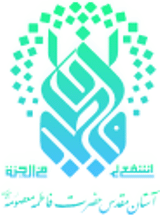 image located by William Garrison,
14 June 2024
image located by William Garrison,
14 June 2024
Source:
https://int.amfm.ir/en/ziyarat-of-lady-fatima-masuma/
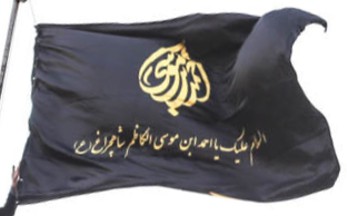 image located by William Garrison,
30 May 2024
image located by William Garrison,
30 May 2024
Source:
https://es.irna.ir/photo
A flag flying over the dome of the "Hazrat Shah Cheraq Holy Shrine" in Shariz,
Iran; credit: Reza Ghaderi (IRNA). Per Wikipedia, "Shah Cheragh Holy Shrine is
one of the main attractions of Shiraz, and also an important religious site in
Iran, which is the holy shrine of Ahmad and Mouhammad, the sons of Musa
al-Kadhim the seventh Imam of Shiite Muslims and brothers of Imam Reza the
eighth Imam. .... The name of Shah Cheragh, which literally means "King of the
Light" (or maybe "Oh King! The Light!"), refers to a local mythical story about
an old woman who notes a light from afar once a week, and when she reports this
to the king, they find out that this light shines above a place which turns out
to be the grave of the old son of Musa Ibn Jafar (Musa al Kadhim). Then the king
decided to build a fancy shrine over the grave."
Info source:
https://packtoiran.com/blogs/
William Garrison, 30 May 2024
Ali-Allah Liege flag
 image located by
Valentin Poposki, 9 December 2011
image located by
Valentin Poposki, 9 December 2011
I was able to contact أحمد سميح مصالحة (Ahmad Sameeh Massalha) who kindly helped identify this flag. The gold text عليٌ ولي الله means "Ali is God's liege" or "The liege from God". Ahmad says this is another Shia Muslim banner declaring their allegiance to Ali (Hussein's father), the 4th Muslim caliph whose death preceded and actuated the Shia-Sunni split.
Esteban Rivera, 28 August 2020
Full image at http://blog.travelpod.com/travel-photo/skiwiman/1/1226176140/flag-with-farsi-scriptx-naxin.jpg/tpod.html
This flag is described as "Flag with Farsi script, Na'in" on the source
web page.
Valentin Poposki, 9 December 2011
This Shia-Muslim flag reads in Farsi (from right-to-left) as: "Ali waliu
Allah". "Waliu" has several meanings: liege/(allegiance), guardian,
custodian/(successor), protector, or helper. As mentioned in an Esteban Rivera
note, this expression literally means that Ali is pledging his allegiance to the
Muslim god: Allah. But there is deeper significance to this flag. "Ali bn Abi
Talib†was Mohammad's cousin and son-in-law, and he was the fourth Sunni-Muslim
"caliph" (political-religious leader of the Muslim "ummah" or "community"), as
well as the first Shia-Muslim "Imam" (political-religious leader). Numerous
sayings of Muhammad praise Ali, the most controversial of which was allegedly
uttered by the Muslim prophet in 632 at the Ghadir Khumm: “Whoever I am his
mawla [leader/master], this Ali is his mawla." That same directive is reprinted
at the top of this flag in a curved slogan: “Man kunto maula fa-haaza ‘ali-yun
maula". To Shia-Muslims, Muhammad was naming Ali as his successor – not as an
additional prophet, but to continue to champion Mohammad's religious Islamic
revelations. To make a very long story short, following Ali’s assassination in
January 661 CE, his Shia heirs claimed leadership of the overall Muslim ummah,
but they had few followers, as most Muslims eventually coalesced around Sunni
leaders. [For the lengthy succession details, see Wikipedia “Ali ibn Abi
Talibâ€.] Shiites claim that from Ali and his descendants (known as the "Ahl
al-Bayt" family) that they are still the only rightful political and religious
successors to Muhammad for interpreting Islam. This flag can be readily
identified as a Shia flag, as at the bottom there is curved line – which is the
long flowing stylized "i/ee/y" in "Ali" [ عليٌ is pronounced as "ilee"] – which
at its left end it is shaped as the doubled-pronged sword called "Zulfiqar".
Shiites contend that this sword was originally carried by Mohammad, who later
gave it to Ali. The Shia argue that Mohammad's action of giving his sword to Ali
reinforces their claim that Mohammad was favoring Ali as his successor. So, this
flag essentially announces the dominance of "Ali is the liege/protector of Allah
and Islam", and, thereby, the Shia should lead the Muslim community. However, as
the Sunni comprise about 80% of the Muslim ummah, they reject the "wannabe"
leadership claims of the minority Shia -- who comprise about only 15% of all
Muslims. A long story here, but it explains the little-known background of the
non-obvious meaning of this flag. So few words on this flag, but so much
meaning.
William Garrison, 17 August, 2024
"Labbaik Ya Mahdi" orange single-line slogan variety
 image located by William Garrison 30
May 2022
image located by William Garrison 30
May 2022
Source:
https://www.haaretz.com/israel-news/
A flag reading in Farsi (read:
right-to-left): "Labbaik Ya Mahdi" or in English: "I am here, Oh, Mahdi". Seen
being paraded during a Tehran funeral procession of IRGC-Quds Force Colonel
Hassan Sayyad Khodaei in late May 2022. Essentially, any Shia-Muslim parading
this flag is informing the "hidden Imam" that his devotees are appealing for his
quick return to create the "End of Times" and thereby bring about the cleansing
of ill-doers. Credit: WANA NEWS AGENCY/ REUTERS.
William Garrison, 16 June
2024
"Labbaik Ya Mahdi" flag - Red two-line slogan flag
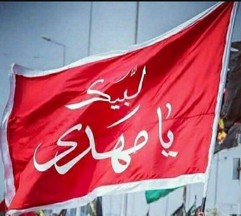 image located by William Garrison,
21 August 2024
image located by William Garrison,
21 August 2024
Source: https://i.pinimg.com
A red-field Shia-Muslim flag with a two-line white Arabic slogan that reads:
لبیک or "Labbaik" on the top line, and on the bottom: "Ya Mahdi", which when
combined read: "Labbaik Ya Mahdi" or "Here I am, Oh, Mahdi". "Muhammad ibn Hasan
al-Mahdi" is believed by the "Twelver Shia" to be the last of the Twelve Imams
and the eschatological Mahdi, who will emerge in the "End of Time" to establish
peace and justice and redeem Islam. Essentially, any Shia-Muslim parading this
flag is informing the "hidden Imam" that his devotees are appealing for his
quick return to create the "End of Time" and thereby bring about the cleansing
of ill-doers. Also, the person parading this flag is informing the spirit of the
"Hidden Imam" that he is willing to assist the Mahdi in achieving his religious
mission.
William Garrison, 21 August 2024
"Labbaik Ya Mahdi Commander!" variety
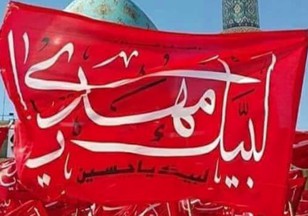 image located by William Garrison,
21 August 2024
image located by William Garrison,
21 August 2024
Source: https://i.pinimg.com
This is a Shia-Muslim flag that beseeches the "Hidden Imam Mahdi" to assist
distressed Shiites. A red-field flag with what appears to be a three-line white
Arabic slogan. However, it really is just a two-line white Arabic phrase that
reads: لبیک or "Labbaik" on the bottom white line, and the middle white line
reads: "Ya Mahdi!", which when combined read: "Labbaik Ya Mahdi!" or "Here I am,
Oh, Mahdi!". What appears to be a long thin white line at the top is just a
fancy long script of the "middle" letter "k" in Arabic: ـكـ. [I believe this
fancy long line is just an artistic attempt to symbolically "box frame" the word
"Mahdi" -- with the English "L" letter that in Arabic looks backwards as: ل --
at the far right and is balanced with a similar-looking exclamation mark (!) on
the left side.] At the bottom of this flag is a black slogan reading "Peace be
unto you, Oh, Commander of the Faithful" that gives him a rank/title of
"Commander". Usually, this title is reserved for Imam Ali, but it can designate
the leader of any Muslim community. Essentially, any Shia-Muslim parading this
flag is informing the "hidden Imam" that his devotees are appealing for his
quick return to create the "End of Time" and thereby bring about the cleansing
of ill-doers. Also, the person parading this flag is informing the spirit of the
Mahdi that he is willing to assist him in achieving his religious mission. There
are small black diacritic marks above various consonant letters to indicate the
placement of vowels – which are not usually shown in Arabic words. [There is a
hidden flagpole sleeve at the right hoist side.] This black slogan is shown as a
light-blue neon sign atop the entrance to Imam Ali's shrine in Najaf, Iraq, as
the fourth photograph down the page at
https://www.independent.co.uk/independentpremium/long-reads/arabic-calligraphy-tradition-history-wadi-al-salam-iraq-b1076705.html.
William Garrison, 21 August 2024
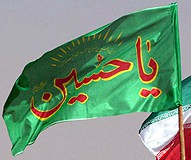 image located by Esteban Rivera,
30 November 2014
image located by Esteban Rivera,
30 November 2014
In this picture (http://www.thetruthseeker.co.uk/wordpress/wp-content/uploads/2014/02/Saeqeh-fighter-jets-Iran-Air-Force1.jpg, source: http://www.thetruthseeker.co.uk/?p=90142) taken back in 2010, there is a green flag in the middle with red lettering.
It seems to be a religious prayer: "Yā Hussain is an Arabic phrase used by
Shia Muslims to invoke the memory or intervention of Hussain ibn Ali. It is
especially used in the context of the Mourning of Muharram."
Source:
http://en.wikipedia.org/wiki/Ya_Hussain
I've also seen the following variants:
- Black background with red
letters (see image at Ya Husain flag):
http://m5.i.pbase.com/o4/93/329493/1/59130245.IranMar062629.jpg (source:
http://www.pbase.com/image/59130245)
- White background with red letters:
https://muharramnyc.files.wordpress.com/2014/10/hussain1.jpg (source:
http://pixgood.com/ya-hussain-flag.html))
Here is the explanation:
Iran Islam Shia Ya Husain Religious, Political
& Military Flag
The Inscription on the flag reads YA HUSAIN. He was the
3rd Imam of all Shia who was martyred in Karbala, Iraq, centuries ago & is a
symbol for all Shias to raise against the Oppressors.
The wording above
YA HUSAIN is the Famous Hadith of Prophet Muhammad that reads: " INNA-HUSAIN
mISBAHUL-HUDA WA SAFINATUN-NAJAT" that means Husain is the Lighthouse of Islamic
Guidance for the lost ships & the Rescue ship.
Such flags are mostly used
by Shia Political & Military Groups in Iran & Lebanon."
Source:
http://www.mecollectibles.com/en/flags/1636-iran-islam-shia-ya-husain-religious-political-military-flag.html
Esteban Rivera, 30 November 2014
Not quite sure if it is a religious phrase. Mourning of Muharram was the day
Hussain was murdered (some kind of genesis story of Shiite vs. Sunnite Muslims).
Basically it means something like "Remember Hussein" (and forever don't be
friend with his murderers). The event marks the anniversary of the Battle of
Karbala when Imam Hussein ibn Ali, the grandson of the Prophet Muhammad, and a
Shia Imam, was killed by the forces of the second Umayyad caliph Yazid I at
Karbala.
http://en.wikipedia.org/wiki/Mourning_of_Muharram
Dirk Schönberger,
30 November 2014
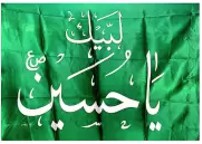
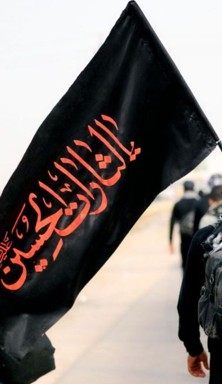 images located by William Garrison,
19 August 2024
images located by William Garrison,
19 August 2024
Sources: https://www.flipkart.com/zohastore, https://x.com/Aon_kirmani1
A Shia-Muslim flag with the Farsi slogan: لبيك يا حسين or "Labbaik ya Hussain",
which means literally: "I am here, Oh, Hussain!", and implying: "I am here to
support you, Oh, Hussain!" A person parading this flag is appealing to Imam
"Hussain ibn Ali" to help distressed Shiite Muslims. Hussain was the grandson of
the Muslim "Last Prophet" Muhammed. Hussain was killed at "Battle of Karbala",
Iraq, in October 680 CE. It is especially used in the context of the Shiite's
annual mourning of Hussain being killed on Ashura (the 10th day in the month of
Muharram). The "Arbaeen Pilgrimage" marks the end of a 40-day mourning period
following the day of Ashura, the religious ritual that commemorates the death of
Imam Hussain. [Flag colors: green = Muslim; black = mourning; red = avenge
Hussain's killing.]
William Garrison, 19 August 2024
There's a variant of this flag which is a red horizontal background with the inscription in Arabic "ياحسين" (English: Oh Hussain).
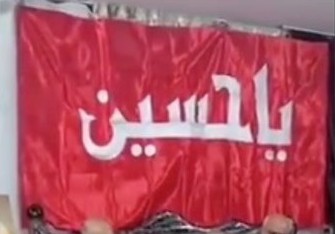 image located by Esteban Rivera,
1 October 2024
image located by Esteban Rivera,
1 October 2024
Source:
https://www.jfeed.com/news-israel/skokrt and
https://x.com/vianack22
#ThxBBfromIran is trending as Iranians take to social media to thank Netanyahu
for killing Nasrallah. In an image several IRGC Generals are seen during a
meeting in which the image is portrayed in the background, the image itself a
screenshot from a video at 0:18.
Esteban Rivera, 1 October 2024
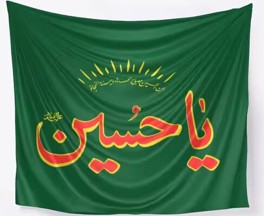 image located by Esteban Rivera,
1 October 2024
image located by Esteban Rivera,
1 October 2024
Source:
https://spanish.alibaba.com/product-detail/Ya-Hussain-Iranian-Flag
This version has an additional inscription in Arabic as follows: "ان الØسين
Ù…ØµØ¨Ø§Ø Ø§Ù„Ù‡Ø¯Ù‰ وسÙينة النجاة" (English: al-Hussain is the lamp of Hadith
('remnant', purported words and the silent approvals) and the Sunnah (the body
of traditions and practices) of Salvation).
Esteban Rivera,
1 October 2024
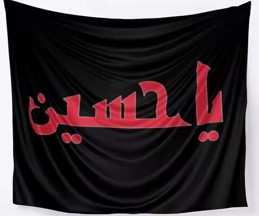 image located by Esteban Rivera,
1 October 2024
image located by Esteban Rivera,
1 October 2024
Source:
https://spanish.alibaba.com/product-detail/Ya-Hussain-Iranian-Flag
 image located by Bill
Garrison,
21 November 2022
image located by Bill
Garrison,
21 November 2022
On 4 Jan 2020 various media reported that a "Red flag of jihad war" had been
raised above the Jamkaran mosque in the Shiite holy city of Qom, Iran. Rather
than being raised as an actual "declaration of war" by Iran against the U.S., It
had been raised in memorium to honor Iranian Gen. Qasem Soleimani, who had been
killed by an American-drone airstrike early on 3 Jan 2020. The white slogan on
the red flag reads: "Those who want to avenge the blood of Hussein", who was a
Shiite warrior who died as a martyr/shahid in battle in Oct. 680 AD in Karbala,
Iraq. Its raising heralds a declaration that Shiites are ready for war against
the U.S. in retaliation for both the killing of Soleimani, as well as in
opposition to the economically harmful U.S.-led oil embargo against Iran. Red
flags in Shiite tradition symbolize both blood spilled unjustly (such as Hussain
& Soleimani) and serve as a call to avenge a person who is slain while defending
either the Shiite religion or the Shiite-oriented Iranian government. Other
similar "Hussain" commemoration flags are usually less militaristic, in that
that they usually merely read "Ya, Hussain" in a prayerful appeal for Hussain's
spirit to assist troubled Shiites.
source:
https://metro.co.uk/2020/01/04/iran-unfurls-red-flag-show-ready-war-us-air-strike-12001520
and/or
https://www.thesun.co.uk/news/10670210/iran-unfurls-red-flag-ready-for-war/
William Garrison,
5 January 2020
Various media are claiming that a "Red Flag of Revenge" has been flown at the same mosque.
"Iran Raises ‘Red Flag Of Revenge’ In Holy City Of Qom" -
https://charter97.org/en/news/2022/11/2/522507.
Briefly, a Ukrainian officer claimed that this flag raising meant that Iran was declaring war against those countries that were opposing Russia's early 2022 invasion of Ukraine.
and elsewhere:
"WATCH:
Iran unveils red flag of revenge against America at mosque"
Both flags are the same. So now the "Red Jihad War Flag" has morphed into the "Red Flag of Revenge" within the media. In actuality, this "red flag" is not specifically pro-Soleimani, nor anti-U.S., nor pro-Russia, but raised more in a prayerful appeal for Imam Hussain's spirit to assist troubled Shiites during troubling times.
William Garrison, 21 November 2022
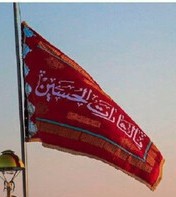
 images located by Martin
Karner,
3 August 2024
images located by Martin
Karner,
3 August 2024
These are slightly different "Red Flag of Revenge" flags than in a video about
the actual situation in the Middle East (from Amir Tsarfati on his channel
"Behold Israel"):
https://www.youtube.com/watch?v=_0zqmi07pkE (see at 19:10 – 19:33 min.).
Martin Karner,
3 August 2024
I have noticed that seemingly each year some Muslim shrine will fly a
revised-design flag that looks similar to the previous year's flag. I believe
the new flag (above left) is an updated, latest and greatest, revised design of
a former, similar flag that is already shown in FOTW. I would include it as a
new version.
William Garrison, 3 August 2024
 image located by Bill
Garrison,
5 April 2020
image located by Bill
Garrison,
5 April 2020
Source:
https://pakistan.asia-news.com/en_GB/articles/cnmi_pf/features/2019/02/22/feature-02
Citation: Pakistan and Afghanistan share a common border. Inside Pakistan,
pro-Sunni-Muslim "Jaish al-Adl" group, which is anti-Shia-Muslim Iran;, c. Oct.
2018.
Jaish al-Adl, is a Salafi jihadist militant organization that operates mainly in southeastern Iran, where there is a substantial concentration of Sunni Baluchis and a porous border with Pakistan.
Bill
Garrison,
5 April 2020
 image located by Bill
Garrison,
3 November 2020
image located by Bill
Garrison,
3 November 2020
I just found another version of the Iran resistance Jaish al-Adl flag:
source:
https://www.thereference-paris.com/1432
Caption: "Members of the
anti-Iranian, Sunni-Muslim "Jaish al-Adl" ("Army of Justice") stand in front of
their militia's flag, c. Oct. 2018."
Bill
Garrison,
3 November 2020
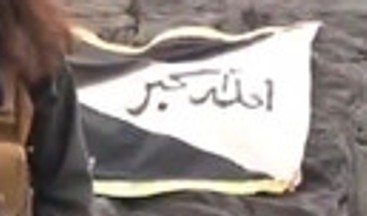
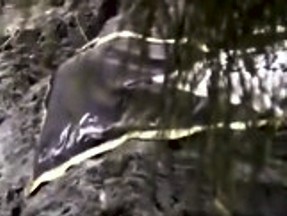 images located by Martin Karner,
9 October 2024
images located by Martin Karner,
9 October 2024
There is a flag or poster of the Balochistan (or Baluchestan) separatist group
"Jaish al-Adl" in Iran. The caption of the video says that the (male) fighter
threatens the Iranian IRGC and officials. Filmed not very cleverly, the fighter
covers a part of the flag/poster. There is a short sequence, where the whole
flag is seen behind branches of a tree. Balochistan is a historic region split
among Iran, Pakistan and Afghanistan. The people call themselves Baloch.
The
somewhat clumsy way the video was filmed and the look of the fighter is not
without a certain humor. It could be that this group has no meaning beyond its
closer surroundings, or it could be that it's part of a growing (?) oppositional
movement in that region.
Source:
https://x.com/Terror_Alarm/status/1841861127682052352
Balochistan
(Wikipedia):
https://en.wikipedia.org/wiki/Balochistan
Martin Karner, 9
October 2024
 image by Ivo Sesnic, 10 October
2024
image by Ivo Sesnic, 10 October
2024
The official flag of the Jaish ul-Adl terror group is presented on Wikipedia.
Having the same background pattern as the flag on X, it's differing in the
inscripted texts. Maybe that flag on X belongs to a sub-group of Jaish ul-Adl,
which is designated as a terrorist group by seven countries. It has a track
record of dozens of killings and kidnappings, mostly IRGC members.
https://en.wikipedia.org/wiki/Jaish_ul-Adl
Martin Karner, 10
October 2024
 image located by William Garrison,
17 January 2020
image located by William Garrison,
17 January 2020
From
https://www.ncr-iran.org:
Astan-e Quds Razavi (AQR), (https://en.wikipedia.org/wiki/Persian_language:
آستان قدس رضوی, is a charitable trust foundation based in Mashhad, Iran. It
manages the Imam Reza shrine and its various other institutions.
2 flag
varieties of same organization. c. Jan. 14, 2020. The first photo shows the flag
having an additional second slogan line.
William Garrison,
17 January 2020
 image located by William Garrison,
17 January 2020
image located by William Garrison,
17 January 2020
 image located by William Garrison,
31 March 2021
image located by William Garrison,
31 March 2021
A green flag with the same design.
Source:
https://www.mehrnews.com/news
William Garrison, 31 March 2021
Both flags are related to Astan Quds Razavi, a charitable trust of Iranian
origin.
Esteban Rivera, 31 March 2021
 image located by William Garrison,
28 April 2022
image located by William Garrison,
28 April 2022
Source:
https://en.abna24.com/news//iran-navy-becomes-regions-determining-force-senior-commander_1222589.html
William Garrison,
28 April 2022
The Astan Quds Razavi Foundation flag is a green horizontal background
featuring the organization's logo in the middle and below it features the
Shahada in yellow colors.
Esteban Rivera,
11 December 2022
Logo
.gif) image located by Esteban Rivera,
11 December 2022
image located by Esteban Rivera,
11 December 2022
Source:
https://globe.razavi.ir
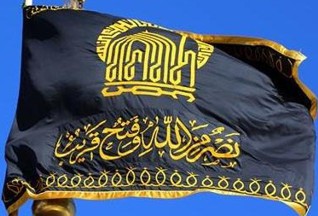 image located by William Garrison,
31 March 2021
image located by William Garrison,
31 March 2021
A black mourning flag for the Shiite-Muslim Imam Reza (d. June 818), at his Holy
Shrine in in Mashhad, Iran; c. 2020.
also see far below green version.
black flag source:
https://ejiga.com/w/5oDPmf6
William Garrison, 31 March 2021
According to an old tradition, the mourning
bodies of Mashhad start covering the religious centers with black
fabrics on the last Friday of the month of Dhu al-Hajjah, but the
beginning of Muharram in Mashhad becomes official by changing the flag
of the dome of Imam Reza (AS) holy shrine. In this ritual, which is
held on the last night of the month of Dhu al-Hajjah, under the title
of Permission for Mourning, the servants remove the green flag of the
golden dome and hoist a black flag instead.
Source:
https://en.hawzahnews.com/news/361305/AQR-hoists-black-flag-over-the-shrine-s-dome-as-sign-of-mourning
Additionally, on special occassions, the mouring flag has been raised as well to commemorate other passings (i.e. https://www.facebook.com/imamrezaen1/posts and https://apnews.com/article
Astan Quds Razavi), established on April 11, 1510 is a charitable trust that has
participation in many economic (industrial, financial, social, educational,
etc.) activities through its multiple subsidiaries and institutions.
Sources:
https://www.ncr-iran.org
https://www.iranwatch.org/iranian-entities/astan-quds-razavi
https://iranfocus.com/economy
https://irannewswire.org
https://en.wikipedia.org/wiki/Astan_Quds_Razavi and
https://fa.wikipedia.org/wiki
For additional information go to Razavi
(official website): https://www.razavi.ir/
Esteban Rivera, 9 December 2024
See also:

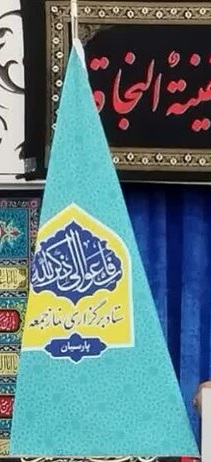 images located by Esteban Rivera,
16 November 2024
images located by Esteban Rivera,
16 November 2024
Sources:
www.afallahi.ir and
www.hawzahnews.com
This seems to be the Friday prayer flag. There even seems to be a website (https://namazjomeh.ir)
but I can't seem to find any further information on its origins nor the
arrangement and meaning of the colors.
The flag is a cyan horizontal
background with the logo in the middle.
The logo bears the inscription in Farsi "قاع الى الله ستاد برگزاری
نماز جمعه شهرستان خوی" (English: Ka'a Allah headquarters of Friday prayer in
Khoy city) which might suggest that depending on the location (the inscription
below), the city name varies so there's one flag for each city. For instance,
there are flags for the city of
Ramsar,
Kerman, etc.
Esteban Rivera, 16 November 2024
.jpg) images located by Esteban Rivera,
16 November 2024
images located by Esteban Rivera,
16 November 2024
Source: https://www.instagram.com/namazjome_khoy
For some quick background, the Christian day of Sabbath is Sunday, for Jews it is essentially Saturday (okay, starting Friday evening to the start of Saturday evening), and for Muslims it is Friday. My contact in Tehran informed me: "The wording on the flag is part of an Ayah [sentence] in Surat [chapter] Al-Jomoah ["Friday"]. It says: "hurry towards saying the Dhikr". The flag is of the "Friday Prayer Organizing Committee for Khoy city". Chat GPT seems a good assistant in translating!
The second picture with Imam is with word [in white Farsi lettering inside the rectangular dark-blue box] Kerman that is the main city in Kerman Province." "Dhikr" is a form of Islamic worship where Muslims repeatedly recite phrases or prayers to remember and glorify Allah/God. The word "dhikr" is Arabic and means "remembrance". As Esteban surmised, different cities may have their own name in the rectangular dark-blue box. From Wikipedia: "Al-Jumuʿah (Arabic: الجمعة, "Friday") is the 62nd chapter (surah/surat) of the Quran with 11 verses (ayah/ayat). The chapter is named al-jumu`ah ("Friday") because it is the day of assembly, when the community abandons trade, transactions, and other diversions in favor of assembling" [such as at a mosque]: https://en.wikipedia.org/wiki/Al-Jumu'ah
William Garrison, 24 November, 2024